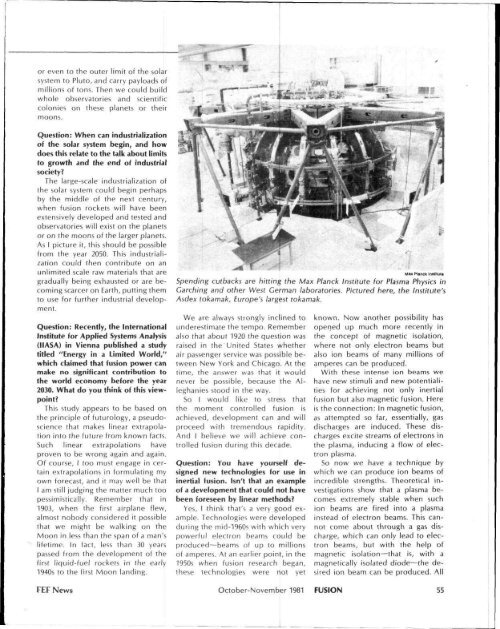Riemann's Contribution to Flight and Laser Fusion
Riemann's Contribution to Flight and Laser Fusion
Riemann's Contribution to Flight and Laser Fusion
- No tags were found...
Create successful ePaper yourself
Turn your PDF publications into a flip-book with our unique Google optimized e-Paper software.
or even <strong>to</strong> the outer limit of the solarsystem <strong>to</strong> Plu<strong>to</strong>, <strong>and</strong> carry payloads ofmillions of <strong>to</strong>ns. Then we could buildwhole observa<strong>to</strong>ries <strong>and</strong> scientificcolonies on these planets or theirmoons.Question: When can industrializationof the solar system begin, <strong>and</strong> howdoes this relate <strong>to</strong> the talk about limits<strong>to</strong> growth <strong>and</strong> the end of industrialsociety?The large-scale industrialization ofthe solar system could begin perhapsby the middle of the next century,when fusion rockets will have beenextensively developed <strong>and</strong> tested <strong>and</strong>observa<strong>to</strong>ries will exist on the planetsor on the moons of the larger planets.As I picture it, this should be possiblefrom the year 2050. This industrializationcould then contribute on anunlimited scale raw materials that aregradually being exhausted or are becomingscarcer on Earth, putting them<strong>to</strong> use for further industrial development.Question: Recently, the InternationalInstitute for Applied Systems Analysis(NASA) in Vienna published a studytitled "Energy in a Limited World,"which claimed that fusion power canmake no significant contribution <strong>to</strong>the world economy before the year2030. What do you think of this viewpoint?This study appears <strong>to</strong> be based onthe principle of futurology, a pseudosciencethat makes linear extrapolationin<strong>to</strong> the future from known facts.Such linear extrapolations haveproven <strong>to</strong> be wrong again <strong>and</strong> again.Of course, I <strong>to</strong>o must engage in certainextrapolations in formulating myown forecast, <strong>and</strong> it may well be thatI am still judging the matter much <strong>to</strong>opessimistically. Remember that in1903, when the first airplane flew,almost nobody considered it possiblethat we might be walking on theMoon in less than the span of a man'slifetime. In fact, less than 30 yearspassed from the development of thefirst liquid-fuel rockets in the early1940s <strong>to</strong> the first Moon l<strong>and</strong>ing.FEF NewsMsx Planch Inllltut*Spending cutbacks are hitting the Max Planck Institute for Plasma Physics inCarching <strong>and</strong> other West German labora<strong>to</strong>ries. Pictured here, the Institute'sAsdex <strong>to</strong>kamak, Europe's largest <strong>to</strong>kamak.We are always strongly inclined <strong>to</strong>underestimate the tempo. Rememberalso that about 1920 the question wasraised in the United States whetherair passenger service was possible betweenNew York <strong>and</strong> Chicago. At thetime, the answer was that it wouldnever be possible, because the Alleghaniess<strong>to</strong>od in the way.So I would like <strong>to</strong> stress thatthe moment controlled fusion isachieved, development can <strong>and</strong> willproceed with tremendous rapidity.And I believe we will achieve controlledfusion during this decade.Question: You have yourself designednew technologies for use ininertial fusion. Isn't that an exampleof a development that could not havebeen foreseen by linear methods?Yes, I think that's a very good example.Technologies were developedduring the mid-1960s with which verypowerful electron beams could beproduced—beams of up <strong>to</strong> millionsof amperes. At an earlier point, in the1950s when fusion research began,these technologies were not yetknown. Now another possibility hasopened up much more recently inthe concept of magnetic isolation,where not only electron beams butalso ion beams of many millions ofamperes can be produced.With these intense ion beams wehave new stimuli <strong>and</strong> new potentialitiesfor achieving not only inertialfusion but also magnetic fusion. Hereis the connection: In magnetic fusion,as attempted so far, essentially, gasdischarges are induced. These dischargesexcite streams of electrons inthe plasma, inducing a flow of electronplasma.So now we have a technique bywhich we can produce ion beams ofincredible strengths. Theoretical investigationsshow that a plasma becomesextremely stable when suchion beams are fired in<strong>to</strong> a plasmainstead of electron beams. This cannotcome about through a gas discharge,which can only lead <strong>to</strong> electronbeams, but with the help ofmagnetic isolation—that is, with amagnetically isolated diode—the desiredion beam can be produced. AllOc<strong>to</strong>ber-November 1981 FUSION 55
















